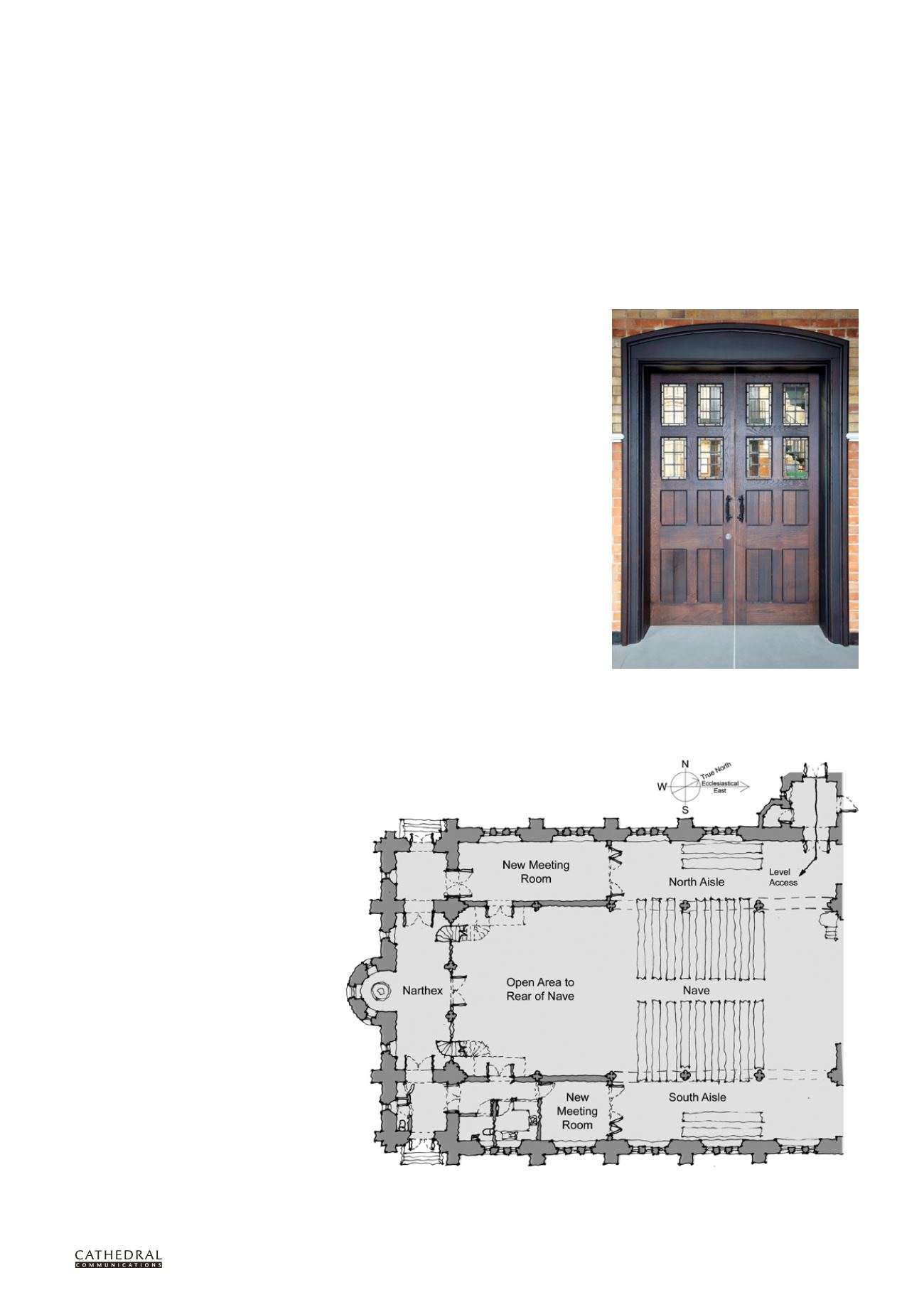

BCD SPECIAL REPORT ON
HISTORIC CHURCHES
24
TH ANNUAL EDITION
9
special mobility requirements, this room
was to provide a baby changing station
for parents and a shower for use by
homeless people.
The architects also prepared a
proposal for new railings with central
gates to the narthex arched openings, in
keeping with the aesthetic of the church,
but of sufficient height to prevent
climbing. These were needed to provide
secure separate access to the main body
of the church when the community
rooms are in use.
Access improvements also included
proposals for a new internal ramp to
the north-east porch, paved with tiles
to match the originals. This would
replace a steep and rather ugly concrete
ramp which had been built inside the
porch, rather than building it externally
where it would detract from the quality
of the architecture and its setting – a
conservation area.
In 2010, the architects prepared
proposals that were sent to the Diocese
of London for their initial feedback.
Because the funds available for the
project were then unknown, the
proposals included two options, one
with community rooms on the ground
floor only and a second option including
upper community rooms with associated
metal staircases to access them. The
architects met with representatives
from the London Diocesan Fund on
site to review the proposed designs
and some amendments were made
to the design of the new railings to
the narthex to reflect other modern
railings at the other end of the nave.
In late 2010 certification was received
from the diocesan advisory committee
(DAC) recommending the proposals, and
a quantity surveyor was then engaged to
prepare preliminary cost estimates for
the different options.
As a place of worship owned by one
of the exempt denominations, alterations
which would usually require listed
building consent are dealt with under the
ecclesiastical exemption, so there was no
requirement for listed building consent.
However, the DAC’s recommendation
included the requirement to consult
with the local planning authority and the
Victorian Society because of the extent of
the proposals and the impact they would
have on the Grade II listed building.
Consultations with Camden
Council conservation officers and the
Victorian Society progressed through
2011 and in December the designs were
presented to the DAC’s plans group
of consultant architects and surveyors
for comments. In addition to requiring
further information from the structural
engineer, the group suggested increasing
the kitchen and toilet facilities, but as
this could not be achieved without losing
one of the two ground floor community
rooms, the proposals remain unchanged.
Following changes in local authority
planning policy, charges were introduced
by Camden Council for all consultations,
and the DAC agreed that further advice
from council officers was no longer
required. However, the Victorian
Society continued to advise and was
supportive of the plans. No objections
were raised to the structural proposals
for the floor or to the new narthex
railings, but the society was concerned
that the full-height infills within the
aisle arches to form the new community
rooms could cause visual harm. Further
discussions addressed the position
of the walls in relation to the arch
columns and the form of construction
the new insertions should take.
Following the preliminary cost
estimates prepared by the quantity
surveyor, it was decided to tender
the project in November 2013 as the
church needed to be absolutely sure that
adequate funding was in place before
appointing a main contractor. From the
tenders received it was apparent that
extra fundraising would be required.
Furthermore, costs increased when,
in another part of the church, the
roofs above the north and south aisles
together with their cast iron gutters and
downpipes also began to need attention.
The favoured main contractor undertook
these repair works in 2014 following
receipt of a separate faculty from the
London DAC, in advance of the major
internal project. Unfortunately, this main
contractor went into administration in
early summer 2015, so a new tender issue
was planned.
In line with the established
conservation principles, it was decided
One of the new community room doors with
traditional leadwork and bespoke ironmongery
(Photo: Thomas Erskine)
Plan showing the new meeting rooms and their separated access route via the narthex


















